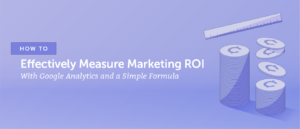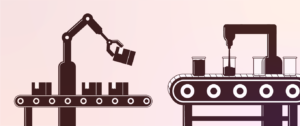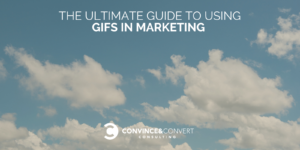How does design happen, and how do designers and marketers collaborate? As a common courtesy, provide details to get more work done better and faster. CoSchedule is consistently committed to quality design and creative output.
Today’s guest is Tim Walker, visual designer at CoSchedule. Tim talks about how he infuses brand with individual style that is distinctly CoSchedule. Discover how to replicate CoSchedule’s processes and philosophies.
[podcast_motor_player]
Some of the highlights of the show include:
- Onboarding: Intimidating, exciting, and challenging to integrate individual style
- Standards and Guidelines: Set and define them to have fun within them
- Design Playground: Time and place to test new ideas, styles, and color palettes
- Collaboration Challenge: Communicate clearly about team/department needs
- What Works, What Doesn’t: Specificity, purpose vs. vagueness, no direction
- Intent: Good design doesn’t happen by accident, it takes thoughtful planning
- Investment: Don’t cut corners—good aesthetics authenticate your brand
- Inspiration: Collect designs from Pinterest, Dribble, Ehance, and Instagram
Links:
- Tim Walker on LinkedIn
- Ben Sailer on LinkedIn
- CoSchedule
If you liked today’s show, please subscribe on iTunes to The Actionable Content Marketing Podcast! The podcast is also available on SoundCloud, Stitcher, and Google Play.
Quotes from Tim Walker:
- “Every designer has their own style. A lot of designers can do a lot of things, but I think each designer kind of has their own unique kind of signature. Integrating that into the brand, that’s always a fun little challenge.”
- “It’s really important to kind of have those standards set in place and well-defined, and then you can kind of have some fun within those. It was enjoyable to try to meld my own style with the existing guidelines.”
- “Everyone’s really great at communicating exactly what they need from design and the purpose of the design, too, and what we’re trying to achieve with it.”
- “If you have valuable content to share, why not give it some great clothes to wear?”
- “Humans are visual creatures. When we see images, our brains store the details verbally and visually. If you want people to pay attention to your content, and recognize your brand, or buy your product, share your posts, you need to have strong design or you’ll be forgotten and ignored.”
[Tweet “How CoSchedule makes design magic happen (and how you can, too) with @wim_talker from @CoSchedule.”]
Transcript:
Ben: Hey, Tim. How’s it going this morning?
Tim: It’s going. How are you doing, Ben?
Ben: Trying to keep warm with the -30 wind chills that we have here in North Dakota this morning.
Tim: Yeah, same. I haven’t felt my face since two weeks ago.
Ben: If I hadn’t looked in the mirror recently, I would be convinced I don’t have a face right now.
Tim: I saw you this morning and I can confirm that you do.
Ben: Thank you. I need that reassurance because it is pretty numbing outside.
Tim: Sure.
Ben: Before we digress too much further, would you mind taking a moment just to introduce yourself to our audience and explain what you do here at CoSchedule?
Tim: Sure. My name is Tim Walker. I’m a digital designer here at CoSchedule. I work closely with the marketing team on design, illustration, animation, and things like that for projects that support inbound marketing, product marketing, marketing automation, and some of our other product design teams, along with just any other little miscellaneous design tasks that might pop up.
Ben: When you joined CoSchedule, was it a couple of years ago now?
Tim: I joined last October. A year and a few months, so still pretty fresh.
Ben: For sure. I feel like I have a terrible perception of the passage of time these days. Back when you joined, our company had a pretty well-defined brand and a pretty well-defined visual identity. I think that if you were to see a piece of CoSchedule content or something that had the CoSchedule branding on it if you are familiar with who we are, you could probably tell who it came from before you even saw a logo.
How did you approach bringing your own style and your own philosophies on design into the role? How did you take the way that you feel things should be done and make that fit within an established visual identity? I think it’s pretty remarkable just how seamless things felt when you came on board.
Tim: Honestly, it’s always a little intimidating and exciting for a designer to dive headfirst into a new brand or visual style because every designer has their own style. A lot of designers can do a lot of things, but each designer has their own unique signature. Integrating that into the brand is always a fun little challenge when you’re introduced to a new company, product, or campaign.
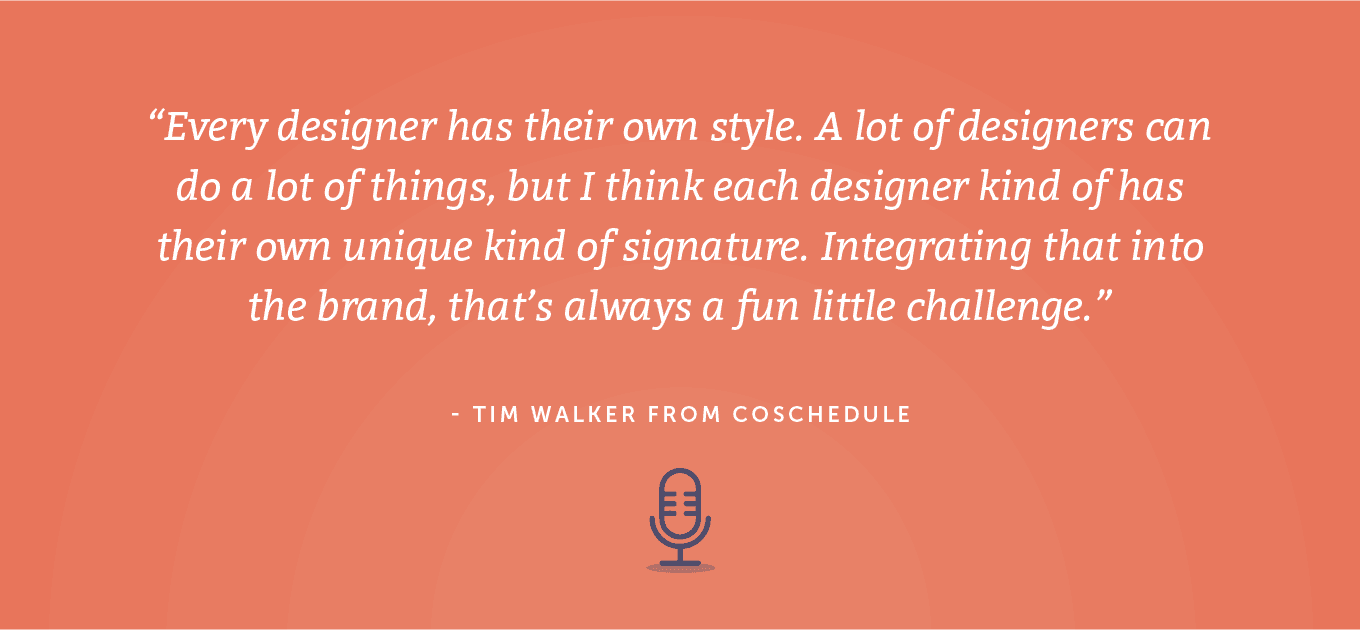
When I started, our design lead at the time, Megan, was really good at feeding me projects that I could try out new illustrations and brand styles on, while simultaneously learning what our standards are. It’s really important to have those standards set in place and well-defined. Then, you can have some fun within those.
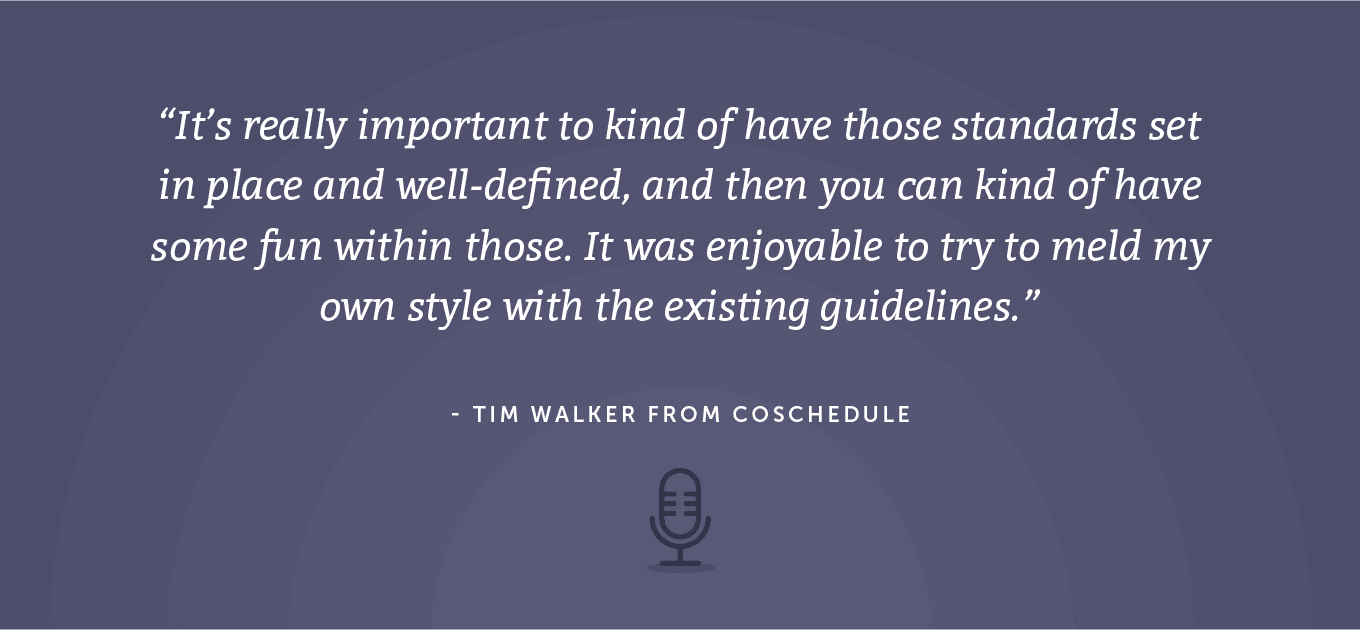
It was enjoyable to try to meld my own style with the existing guidelines. Things like blog posts, product guides, and projects that you come back to and you publish often can be a fun design playground to test out new ideas, new styles, illustration, or any new color palettes—things like that. Since starting, I’ve been trying out new things to see what works and what doesn’t, and filtering those through the lens of the existing and established CoSchedule brand.
Ben: Cool. Something you’ve touched on is you work on all kinds of different projects across our company. Something that I’ve always been curious about is how do you approach collaboration with other departments? Because every department that you have to work with on all these various projects, I imagine, is going to be very different. They just have different ways of working, different things that they need, different ways of communicating, and so forth. How do you approach that challenge?
I have another question to follow up on that, but I’ll let you take them one of a time.
Tim: I appreciate that. Approaching collaboration, I’d say our marketing lead is really great at communicating exactly what teams need from design. There are no vague requests or unclear tasks, which is really nice. I’ve worked jobs in the past where a project can start from someone just walking up to your desk and being like, hey, we need this by this date. Can you do that? It’s like, you got to be more specific than that. I can take something and run with it, obviously, but it’s nice having that specificity.
Here, everyone’s really great at communicating exactly what they need from design, the purpose of the design, and what we’re trying to achieve with it. For example, when a product marketer is whipping up a campaign, instead of being like, hey, we need a design for emails, being really vague about it, and sending a six-page Google Doc with no direction that’s a complete mess and you don’t know what you’re looking at, it’s got weird screenshots.
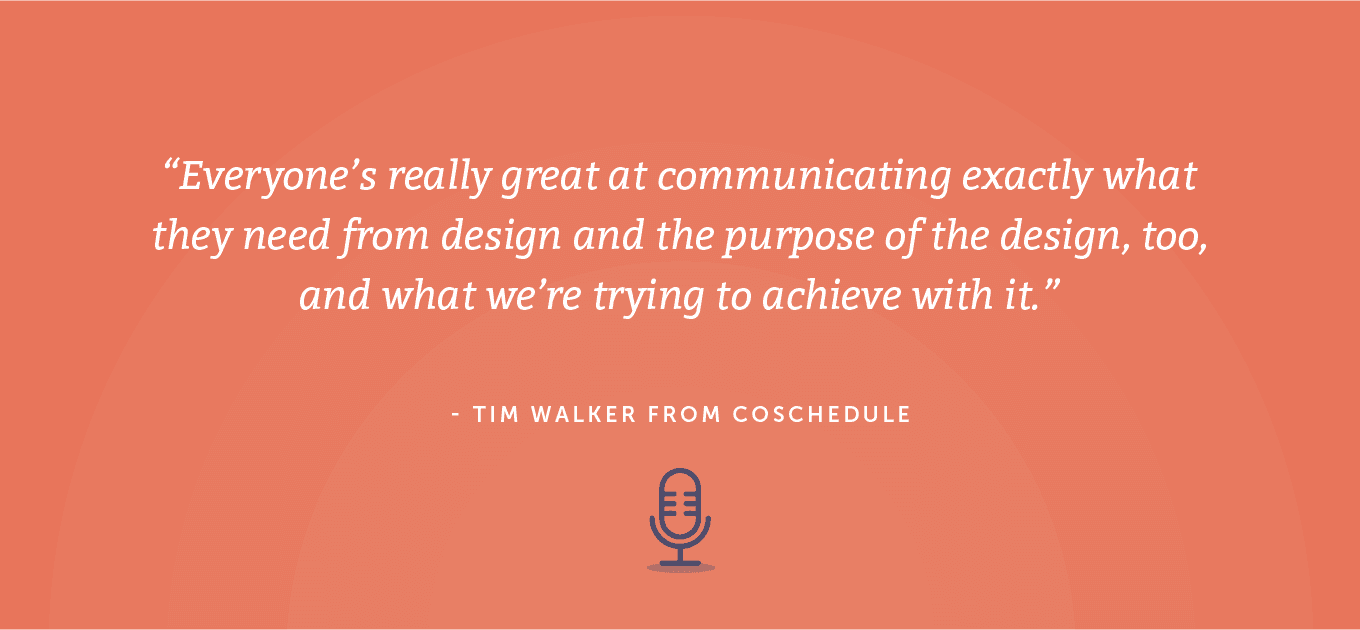
Instead of doing that, they’ll be like, we need three emails design, here’s the campaign, here’s what we’re trying to accomplish, here are the personas that we’re marketing to, and here are some things we could try with the design—some things we found there on the web. And then just giving graphic callouts for where the graphics should be, examples of other campaigns they like, and suggestions of like, it would be really cool if there was a little guy on a boat here or something.
It helps to save so much time and really supercharges productivity to have that more specific context. Using Slack all the time too is really nice. I think that answers your question.
Ben: Yeah. Actually, it does answer it really well. Beyond just being a basic courtesy when you’re working with the design team, you should tell them exactly what you need and don’t be lazy about providing direction.
It’s also interesting that the benefit for everybody there is you get more work done better and faster, which is an elusive outcome for a lot of marketing teams—to be able to balance speed and volume with quality of execution. I imagine, for most of our listeners, that probably sounds like a dream.
Let’s assume someone is listening to this episode and they’re in a position where projects that need design seem to be getting backlogged, or that relationship between design and writers or other stakeholders in that organization is not as collaborative or as functional as it could be for various reasons. If a listener finds himself in that kind of situation, from your perspective, what’s something that they could begin doing that you feel would help them when it comes to getting what they need from the designers that they work with?
Tim: Obviously, our CoSchedule calendar that we use with our tasks, build-outs, and stuff is super helpful. Just having your week planned out beforehand and clearly communicating what the marketers need from design in advance is really useful to know from a project management standpoint.
Having syncs beforehand and little kickoff meetings with each project—even if it’s a really small thing—is something that has been really effective for our team, the productivity of the design team, and just making sure everything’s on the table from the get-go. That everything is right there at the start so that everyone’s on the same page, and you can get readied into the work as soon as the kickoff’s done.
That’s really useful instead of, like you said, backlog projects of, when you have time, can you work on this? Just being really intentional about what the scope project is and why you need it.
Ben: Something that Tim mentions that’s worth focusing on for a moment is intent. Good design doesn’t happen by accident. It’s the result of thoughtful planning and strategy that’s connected back to the company’s goals and not just some group of artists in your company that is off on their own and creating stuff that looks nice without regard for business outcomes.
The more that you can attach the value of design to growing your business, the easier it will be to make the case to internal stakeholders—whether that’s your boss, CEO, or whoever—that investing in design is really an investment in your entire organization. And as marketers, having quality design and just access to that skill set—when it comes to planning and executing your projects—has massive ramifications for your work and the outcomes that you can expect to drive. Now, back to Tim.
Most of our readers and listeners to the show are probably familiar with your team’s work through our blogs, social media channels, various guides, and ebooks we’ve created over the years, or maybe our customer marketing materials, even in-app messages.
They probably have seen things that you or your team have worked on all over the place across all different touchpoints—would be the marketing term—whether they’re on our site or on our product. I really think that the benefits of making that investment in design that we’ve made at CoSchedule—you can see it pay off. When you’re interacting with anything that CoSchedule puts onto the world, you can really see the impact that an investment in design can make.
From your perspective, why do you feel it’s important for companies to make an investment in design, particularly when it comes to product marketing or content marketing, and to not cut quarters if they don’t have to?
Tim: I’d say the obvious answer is that it’ll set your content or product apart and show that you’re credible. A good aesthetic will authenticate your brand.
The Internet has become a sea of templates, stock photos, and stock graphics. There’s nothing wrong with that if you’re a really small team using some of that stuff. But putting thought and effort into a unique design and thoughtful branding really shows that you’re serious about what you’re doing and that you’re not just publishing or producing on a whim.
If you have valuable content to share, why not give it some great clothes to wear? It’s universal too—the principles of good design. Well done and interesting design means people are going to use what you’re putting forth more readily and they’re going to remember you.
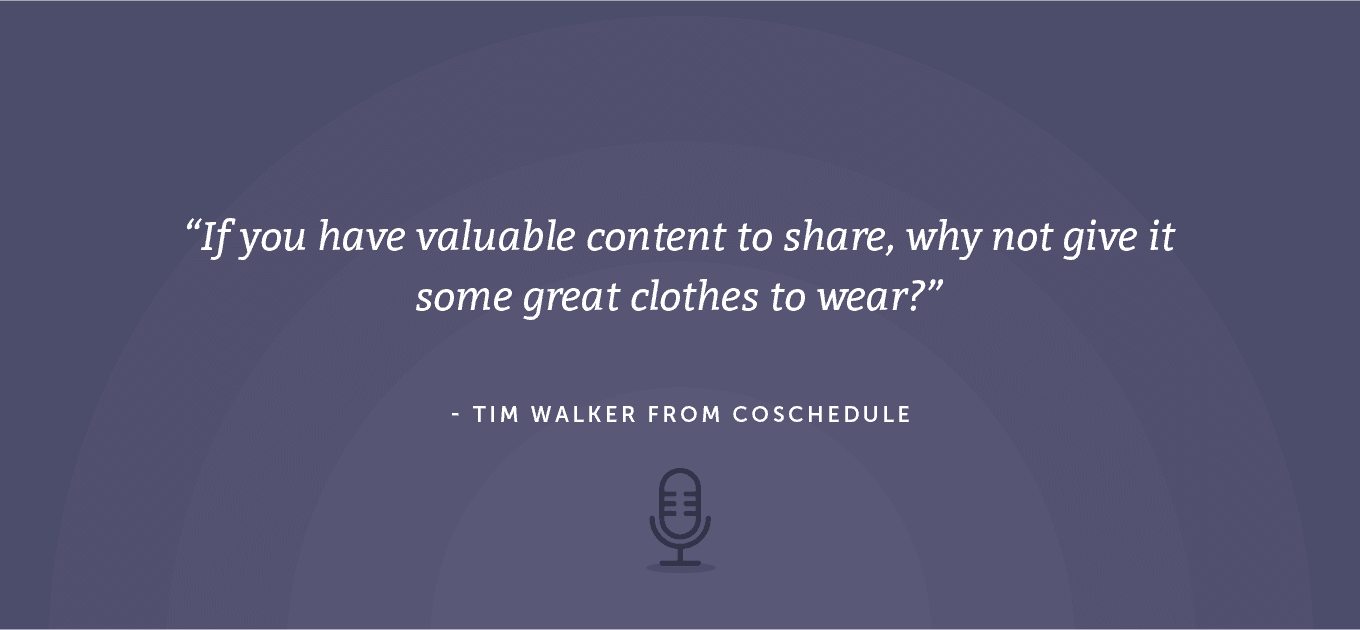
Like you said earlier in the conversation, being able to notice a company’s brand just by seeing the graphics online, just coming across them, and even before seeing a logo, that’s really important. That sets you apart. It’s an investment that ultimately pays off, and the numbers show that.
Ben: I certainly agree with all of that. This is something that listeners might be surprised to know. I feel like the size of our design team over the years has expanded and contracted at various points—just dependent on a number of different factors. But right now, it’s you and an intern. You manage to put out a very high level of output, and the quality never slips.
I can say for myself, I never worry about what your team is doing. Once something gets handed off, we pretty much just assume it’s going to be great, and we’ve never been let down. How do you do it? How do you maintain that level of quality and consistency without burning out and without having to stay at the office until midnight?
Tim: I appreciate you saying that. The way we avoid staying here 24/7 and still publishing tons of content is through the standards we’ve established as a design team. Having a clear process for each of the projects that we work on regularly is super helpful.
Seeing your tasks ahead of time can really help with that. If I know what I’m going to be doing a week in advance, or if I can see that ahead of time, then I can mentally prepare for that and sneak in a sketch here or there in meetings because I know what I’m going to be working on tomorrow.
I can start thinking about that, mentally prepare for that, and just start coming up with ideas in the back of my head.
Having a clear process and knowing what you’re going to do ahead of time is super helpful. Making sure that if you’re onboarding a new designer, those processes are clearly communicated, just communicating standards, and how things are done. Having that all documented is super helpful.
For our blog design process, for example, we have a document that goes step by step—what you need to do, what graphics need to be created, the dimensions of the graphics—everything you need to know if you’re a brand new designer, how to make a blog. That’s all documented, and I think that helps with productivity. It’s just like getting everything on paper, so to speak.
Also, like we were talking about earlier, the intentionality and purpose of the project is really important to know and will really boost productivity.
Another practical thing is file organization. When designers are going through a design program in college or something, it’s not something that’s usually emphasized enough. A practical way to organize your files in a way that makes them easy to find, that’s super important.
If I want to pull a graphic from a project we worked on last month because I don’t want to redraw something that I just drew, having a good way to find that and being able to access those files quickly and easily is super important. Then just backing everything up, saving libraries of icons, swatch palettes, and all of that stuff is super, super important.
The last thing I’d add is having an easy method for collecting inspiration on designs. Every designer should use sites like Pinterest, Behance, Dribble, Instagram. There are still probably some that I’m forgetting, but just collecting inspiration at all times is something that’s really helped me when I want to try a new style or something like that.
If I have a creative block. Just being able to clip those boards and being like, okay, this was cool, I found this a month ago, I like that, I want to try something similar to that. Just collecting all that inspiration at all times is something I’m always doing and something I would encourage any designer to do. Be like a squirrel before winter with design inspiration. Be a hoarder of information.
Ben: I can attest to the value of having a swipe file or something like that is one way of phrasing it. If you see something that you think looks cool, stash it away.
Tim: Yeah, exactly. Put it in your back pocket.
Ben: Yes, absolutely. This has been great, Tim. I really appreciate you taking some time out of your day. I know you’ve got a lot going on, but I think this has really been a great conversation.
Before we wrap this up, what’s one thing about design that you think marketers need to know? If there’s one piece of advice or one piece of wisdom that you could share that would help marketers better understand the craft and its value, what would you tell them?
Tim: I would emphasize that humans are visual creatures. When we see images, our brains store the details verbally and visually. If you want people to pay attention to your content, recognize your brand, buy your product, or share your post—whatever you need, you need to have a strong design or you’ll be forgotten and ignored. It’s as simple as that.
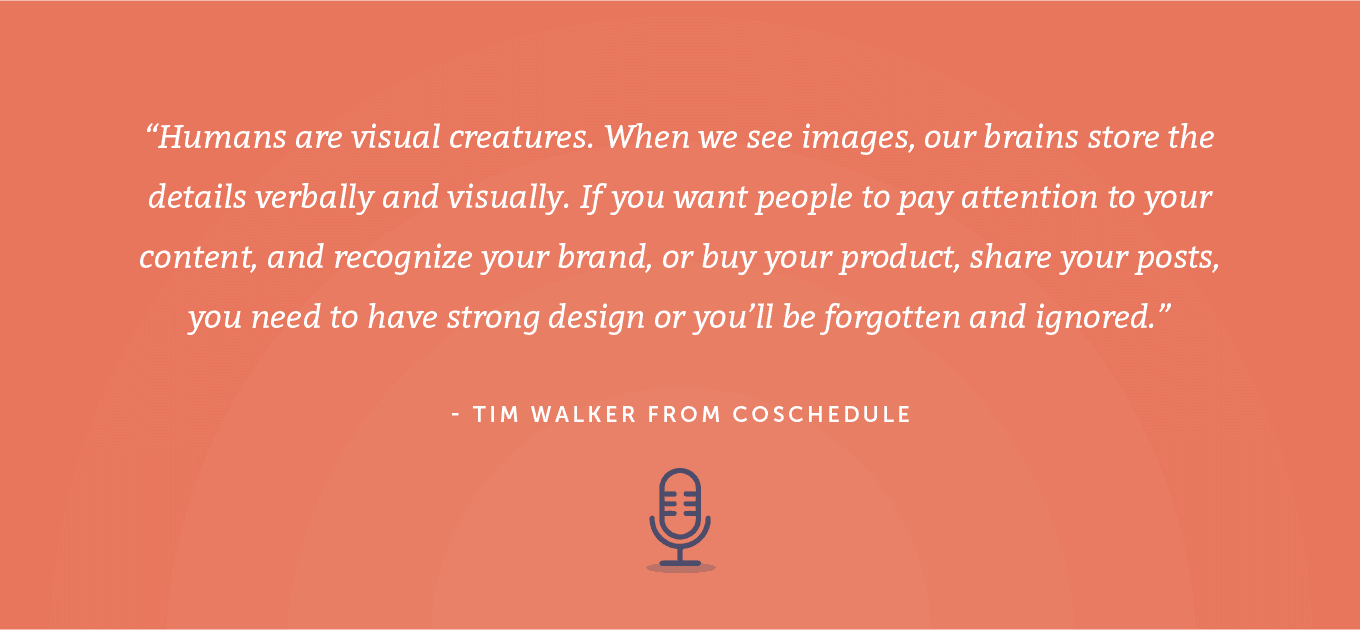
Design is not always about looks, it’s more about communicating effectively. Like we said, the numbers will speak for themselves when you start implementing great design across your platforms. Lots of marketers have writing backgrounds, and they can tend to ignore the importance of design. But you’re doing your company a disservice if you aren’t paying close attention to the importance that visuals will play in your marketing process.
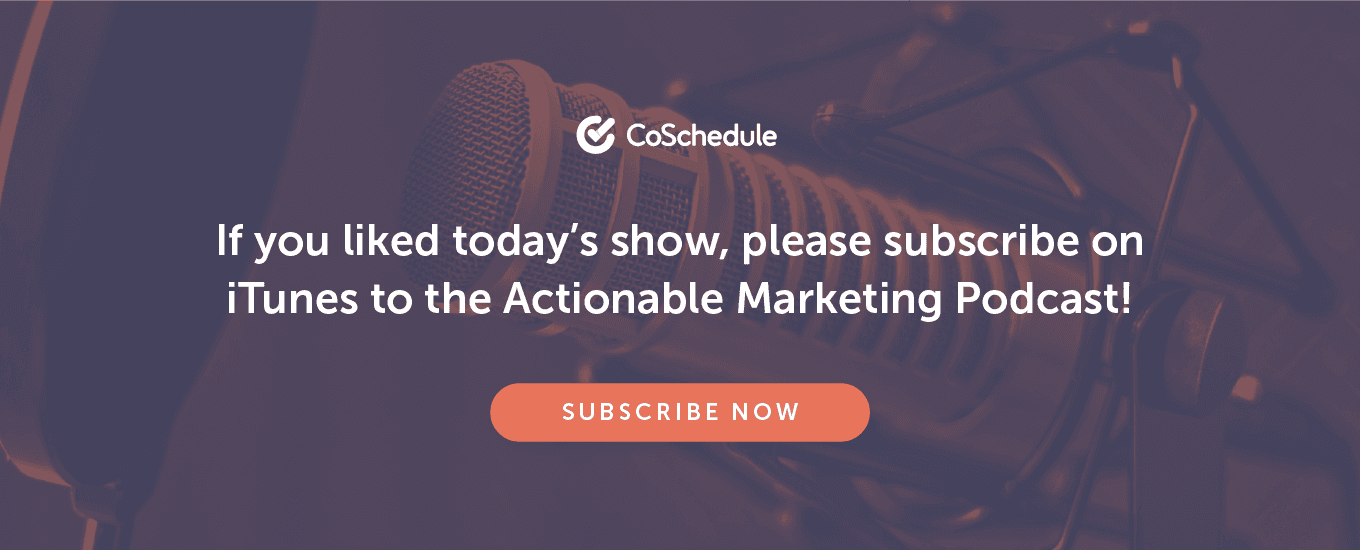
The post How CoSchedule Makes Design Magic Happen (And How You Can Too) With Tim Walker From CoSchedule [AMP 222] appeared first on CoSchedule Blog.

![You are currently viewing How CoSchedule Makes Design Magic Happen (And How You Can Too) With Tim Walker From CoSchedule [AMP 222]](https://www.dimaservices.agency/wp-content/uploads/2021/02/222_Tim-Podcast-Graphics_header.png)
